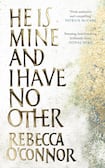
Set in a small town in rural Ireland, Rebecca O’Connor’s debut novel begins with its narrator, Lani, and her best friend, Marjorie, at a school disco. The girls are 15; songs by Bryan Adams and REM are playing, which places the story in the early 1990s. Lani meets and falls in love with a handsome but maudlin older boy, Leon, who is something of a social pariah because his father murdered his mother. The young lovers exchange amorous missives via a go-between (“If you wish to respond to this please give letter to Geraldine McGovern (4th year), and it will reach me safely”) and make grandiose declarations of undying love: “He told me he would keep me close, always. He told me he would watch over me.”
He Is Mine and I Have No Other is a tender portrait of cider-drinking adolescence in all its rawness and sensitivity. Lani experiences her first love as a physical ailment, bringing on sweats and chest pains; when her mother tells her she is expecting another baby, she has to suppress an urge to gob on her. (Controlling her saliva is a problem for Lani: later, in the course of an argument about boys, she gobs on Marjorie.) O'Connor's description of awkward teenage boys at a party is a wryly on-point depiction of the horrors of adolescent courtship: "They were wearing white socks and slip-on black shoes, and all of them seemed to be sporting the same mullet. They'd mutter, 'Dye wanna dance?' then shuffle on to the next girl before you'd even had time to answer, they were that defeated."
The novel’s title is deceptive. It isn’t, as we might expect, an affirmation of Lani’s love for Leon, but comes from a passage in which Leon explains that he still loves his father despite the horrific crime he committed. Indeed many of the most important characters in this story are off-scene – either distant or dead. Lani learns that her grandmother had been forced to give up a daughter who was born out of wedlock. Celia was “A shame best kept hid, forgotten about”, who ended up in Oxford via an orphanage; in Lani’s world she is “just this wee girl on the mantelpiece, suspended in the past.” Lani is also obsessed with a fire at a convent in which 35 children perished. The narrative is punctuated with several chapters told from the perspective of some of those doomed young girls. These include Deidre, aged eight: “My daddy was a man with no backbone. That’s what my mammy told me. I never saw him myself. He must’ve looked queer.”
Cavan fire
These poignant diaristic vignettes are interspersed with matter-of-fact references to punitive beatings and occasional allusions to sexual abuse.The real-life events that inspired this subplot are documented in Mavis Arnold and Heather Lasky's Children of the Poor Clares (1985), which is credited by O'Connor in the the acknowledgements. The Cavan orphanage fire of February 1943 became a symbol of the neglect and abuse that was prevalent in the industrial school system."
The worst of it,” Lani notes, relating her grandfather’s recollection of the event, “was that had the men not been there so soon after the fire started, the nuns might have let the little girls out. It was from their eyes they were protecting them. The girls were made to get down on their knees and say decades of the rosary rather than escape outdoors and run the risk of being seen in their nighties.”
This is both a love story and, in a sense, a ghost story. It is a small, self-contained thing, spare and unembellished in its prose style and – aside from the conceit involving the orphan girls – decidedly uncomplicated in its structure and storyline. This extreme lightness of touch gives He Is Mine and I Have No Other a certain elegiac grace, though it also renders it a little insubstantial – more like an extended short story than a novel. O'Connor's sensitive evocation of the havoc wrought on people's lives by the domineering hubris of religiosity, whether through institutionalised cruelty or the soft power of sexual shame and threats of hellfire, is especially resonant in light of Ireland's historic referendum on abortion rights. Stories like this, which probe the collective memory by shining a light on relatively obscure nooks of social history, play an invaluable part in the societal reckoning that is now under way.










